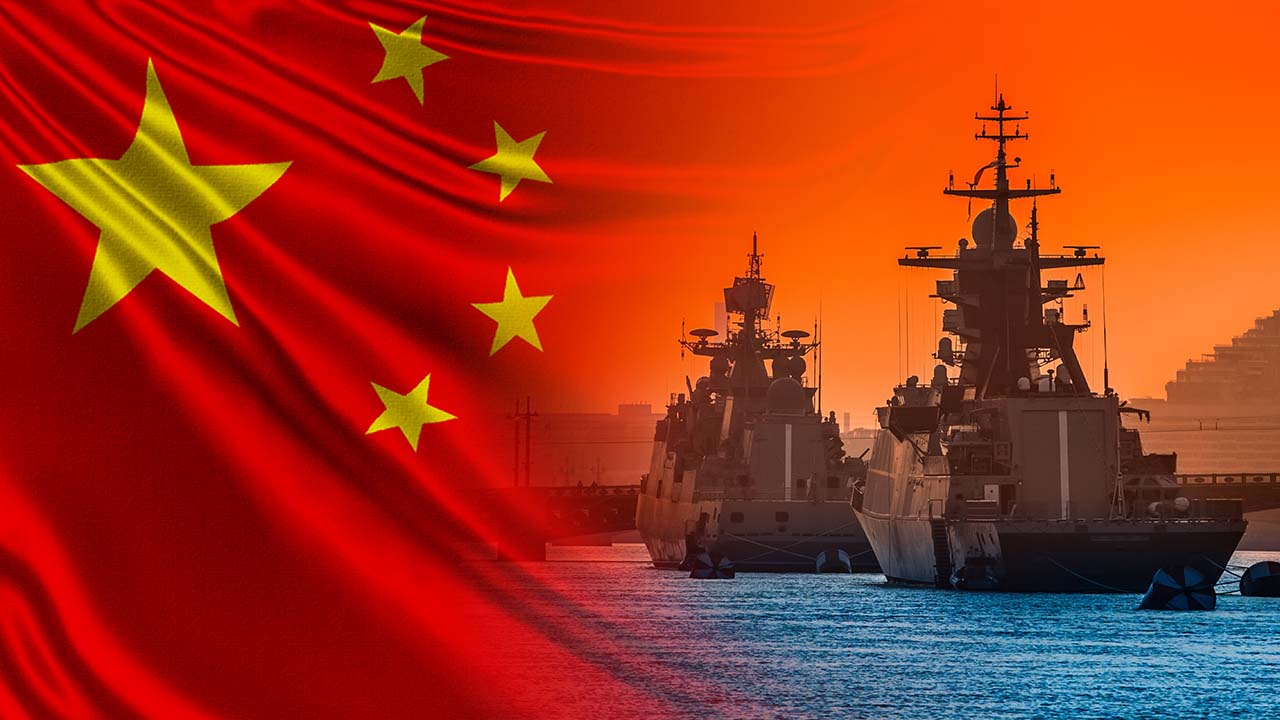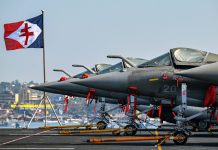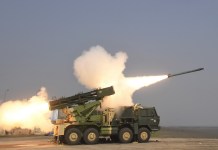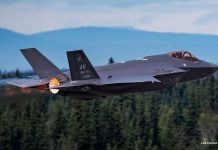It may sound ironic, but notwithstanding his protectionist industrial vision to “Make America Great Again,” President Donald Trump is open to the idea of outsourcing the building of U.S. Navy ships to Washington’s allies in an effort to restore a maritime balance of power with China.
This seems to have generated a lot of goodwill in the ship-building industries in the Indo-Pacific, particularly in Japan and South Korea.
EurAsian Times recently pointed out how the U.S. Navy, “smallest in decades,” required more than one trillion dollars to counter China’s growing naval might.
However, many maritime experts are of the view that the U.S. Navy, constrained by America’s “outdated protectionist” legislations, will find it difficult to restore the maritime balance of power with China and that it needs help from its allies.
The U.S. needs a collective effort and shipbuilding cooperation with Indo-Pacific allies and partners, such as South Korea, Australia, Japan, and the Philippines.
President Trump, it seems, will not mind such help from the Indo-Pacific allies, particularly Japan and South Korea, who, among all the American allies, are viewed to be best-known for their shipbuilding capabilities.
Incidentally, a few days before he took oath for his second term as President, Trump, in an interview on “The Hugh Hewitt Show,” a radio program, had said, “We’re going to do something with ships… We need ships. And we may have to go a different route than you would normally go. …We don’t build ships anymore. We used to build a ship a day. We don’t build ships anymore. We want to get that started. And maybe we’ll use allies, also, in terms of building ships. We might have to. We need ships. China’s building, from what I’m hearing, every four days, they’re knocking out a ship. We’re sitting back and watching, and we’ve suffered tremendously.”
Noting China’s vast outpacing of American shipbuilding capabilities, Trump had added that if America has to go to others and bid out, “ it’s OK to do that. We’ll bid them out until we get ourselves ready. We’re not prepared for ships. We don’t have docks.”
It may be noted in this context that in November last year, South Korea’s Presidential office announced that President Yoon Suk Yeol and Trump had a brief phone call following Trump’s presidential victory. Apparently, in their talks, Trump had underlined the need for the U.S. shipbuilding sector to work with Korea.
A recently released study, authored by Dr. Peter K. Lee, a research fellow in the Center for Regional Studies at Seoul’s Asan Institute for Policy Studies, highlights that China today has the world’s largest navy. In 2024, it had a force of over 370 ships and submarines, inclusive of 140 major surface combatants, compared to 297 for the United States.
China’s fleet is expected to grow to 435 ships by the end of this decade, marking an average increase of eight ships per year. The People’s Liberation Army-Navy (PLAN) is undertaking a fleet-wide naval shipbuilding program that includes new aircraft carriers, guided missile cruisers, guided missile destroyers, guided missile frigates, auxiliary and amphibious ships, and unmanned underwater systems.
This PLAN naval buildup is overwhelmingly recent, meaning that approximately “70 percent of Chinese warships were launched after 2010, while only about 25 percent of the U.S. Navy’s were. China’s newer ships are not necessarily superior, although the U.S. Office of Naval Intelligence assessed in 2020 that China’s ships were increasingly of comparable quality to U.S. ships.”
Even the U.S. Department of Defense assesses that “The PRC is the world’s top ship-producing nation by tonnage and is capable of producing a wide range of naval combatants, gas turbine and diesel engines, and shipboard weapons and electronic systems, making it nearly self-sufficient for all shipbuilding needs.”
China’s shipbuilding capacity is more than 230 times as large as that of the United States, it is said. Chinese shipyards have a manufacturing capacity of roughly 23,250,000 tons, whereas U.S. shipyards have less than 100,000 tons.
China also far surpasses the United States in commercial shipping, port ownership, container construction, fishing fleets, and overall merchant marine fleets, with 7,000 ships compared to 178 for the United States.

On September 24 last year, the Congressional Research Service released a study that talked of the Navy outlining a goal for itself in March 2024.
That goal, as part of its FY2025 30-year (FY2025-FY2054) shipbuilding plan, called for “achieving and maintaining a fleet of 381 manned ships of certain types and numbers, plus 134 large unmanned surface and underwater vehicles.” For this, the Navy’s proposed FY2025 budget requests $32.4 billion in shipbuilding funding.
The Navy projects that 10 new ships will be delivered to the fleet in FY2025. The Navy’s FY2025 budget proposes retiring 19 existing ships in FY2025, including 10 ships that would be retired before reaching the ends of their expected service lives.
As a result, the Navy projects that, under the Navy’s proposed FY2025 budget, the total number of ships in the Navy would decline by a net 9 ships during FY2025, from 296 ships at the start of FY2025 to 287 ships at the end of FY2025.
The Navy’s budget submission projects that during the period FY2025-FY2029 (i.e., the years of the FY2025 Future Years Defense Plan [FYDP]), the Navy would include 287, 283, 280, 286, and 291 ships, respectively. Under the Navy’s FY2025 30-year (FY2025-FY2054) shipbuilding plan, the fleet would grow to more than 300 ships in FY2032 and reach a total of more than 381 ships in FY2042.
Among other reasons, the Congressional research explains delays in deliveries of several types of Navy ships in terms of industrial base capacity constraints for building Navy ships, labor shortages, and inflation in Navy shipbuilding costs.
However, for Dr. Lee, the most important reason seems to be “outdated protectionist legislations that have stifled competition in commercial shipbuilding and efficiency in naval shipbuilding by prohibiting allied partners from helping.”
He explains how the protectionist agenda includes multiple pieces of legislation imposed by the U.S. government, especially the U.S. Congress.
“The United States government explicitly codifies the prohibition of any shipbuilding outside of the United States and its territories. Most prominently, the United States Code Title 10 (Armed Forces), Subtitle C (Navy and Marine Corps), Part IV (General Administration), Chapter 863 (Naval Vessels), § 8679 (Construction of vessels in foreign shipyards: prohibition), states as follows: “(a) Prohibition.—Except as provided in subsection (b), no vessel to be constructed for any of the armed forces, and no major component of the hull or superstructure of any such vessel, may be constructed in a foreign shipyard. (b)Presidential Waiver for National Security Interest.—(1) The President may authorize exceptions to the prohibition in subsection (a) when the President determines that it is in the national security interest of the United States to do so. (2) The President shall transmit notice to Congress of any such determination, and no contract may be made pursuant to the exception authorized until the end of the 30-day period beginning on the date on which the notice of the determination is received by Congress.”
This applies via Congressional appropriations to fund the U.S. Navy by the House of Representatives. For example, the U.S. Navy’s “Justification Book” for Shipbuilding and Conversion notes that funds allocated to naval shipbuilding are made available by Congress, “Provided further, that none of the funds provided under this heading for the construction or conversion of any naval vessel to be constructed in shipyards in the United States shall be expended in foreign facilities for the construction of major components of such vessel. Provided further, that none of the funds provided under this heading shall be used for the construction of any naval vessel in foreign shipyards.”
All these prohibitive measures are related to old Acts like “the Buy American Act” (enacted in 1933, it mandates that federal agencies, including the Department of Defense (DOD), prioritize procurement of items that are predominantly manufactured within the United States), Jones Act ( Enacted in 1920, it requires that cargo shipped between U.S. ports be transported on American-owned ships and that ships be built in the United States), and the Byrnes-Tollefson Act (enacted in 1965, it prohibits the use of U.S. funds for constructing naval vessels and major vessel hull components in foreign shipyards).
Obviously, there is now a realization on the part of many in both the executive offices and Congress about a relook at these old provisions and suitably amend the laws to restore the global supremacy of the U.S. Navy. Such an approach, with which Trump, as already noted, seems to be in agreement, also includes the desirability of multilateral collaborations among the U.S. allies in the Indo-Pacific.
As Dr. Lee says, there could be four key pathways in this regard:
■ The first pathway is to expand ship maintenance, repair, and overhaul (MRO) in allied shipyards.
■ The second pathway is to promote new allied investment both into under-utilized U.S. shipyards and joint investments into Indo-Pacific shipyards, such as in the Philippines, to enable MRO work.
■ The third pathway is to move beyond “battle force ship” definitions to take advantage of the rapid manufacturing of uncrewed vessels to offset Chinese numerical superiority and alleviate workforce shortages.
■ The fourth and final pathway is to lay the legal groundwork to enable AUKUS-like allied manufacturing of auxiliary support ships as well as surface combatants such as frigates and destroyers.
With Trump in a receptive mood, there could be openings of these pathways.
- Author and veteran journalist Prakash Nanda is Chairman of the Editorial Board of the EurAsian Times and has been commenting on politics, foreign policy, and strategic affairs for nearly three decades. He is a former National Fellow of the Indian Council for Historical Research and a recipient of the Seoul Peace Prize Scholarship.
- CONTACT: prakash.nanda (at) hotmail.com




